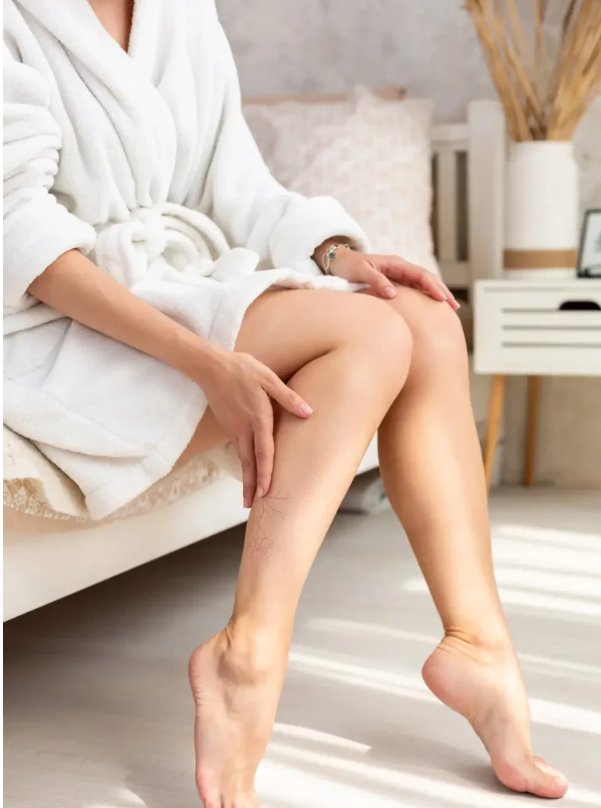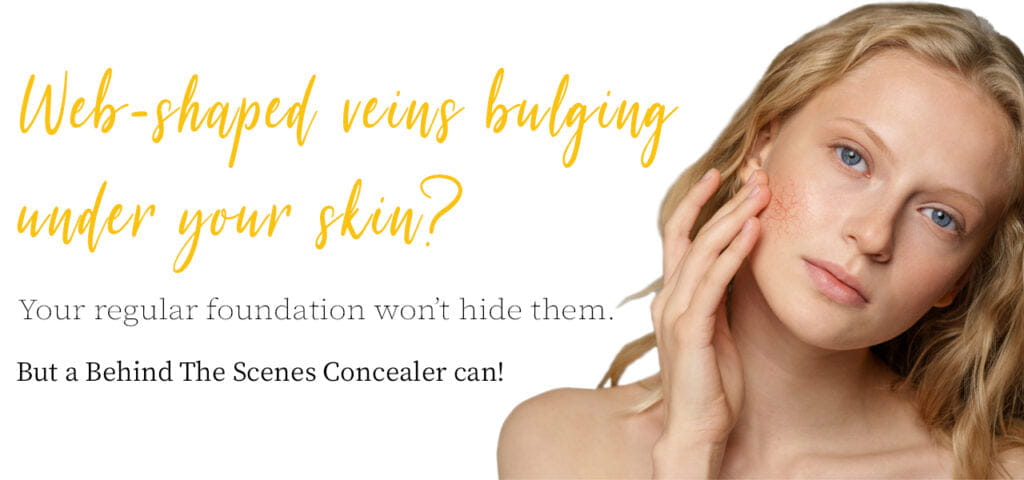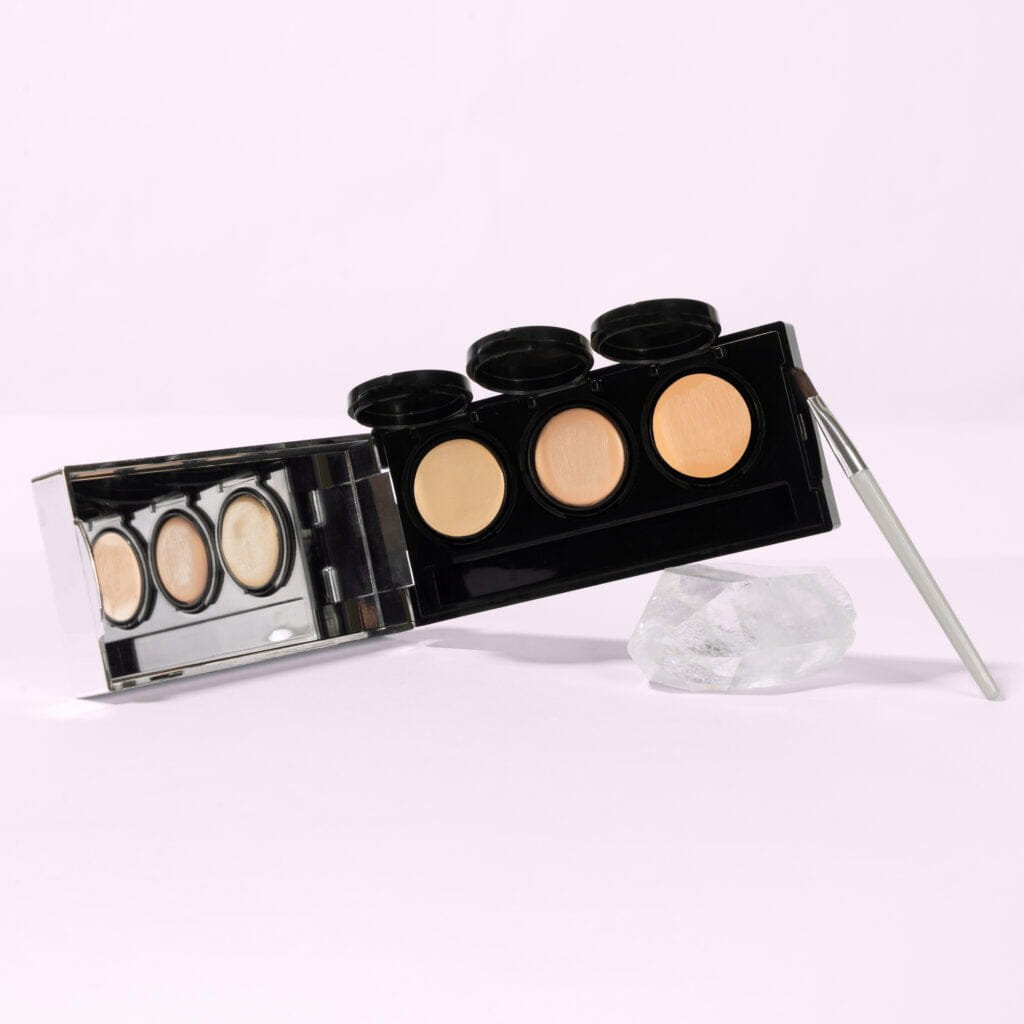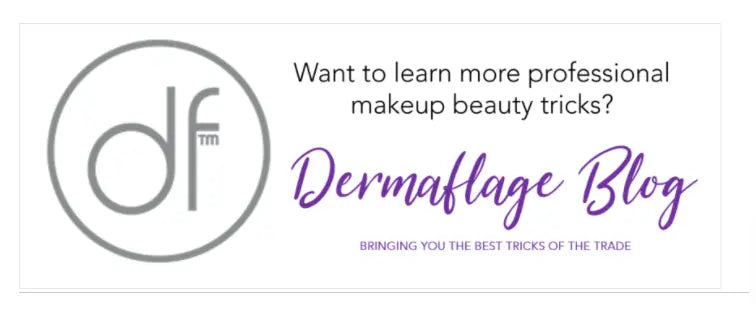
Help! I Have Spider Veins
Share

Keep calm. There are several methods of getting rid of spider veins.
However, it’s important to know how they got there in the first place so you can prevent them from returning.
This article contains everything you need to know about spider veins, from the various temporary solutions (like a hyper-pigmented concealer) to all the ways you can banish them for good.
Just don’t let those webs spoil your summer fun!
What Are Spider Veins?
Also known as telangiectasias, spider veins are small red, blue, or purple blood vessels that protrude through the skin’s surface. They appear when the body’s venous valves and walls weaken, looking like webs under the skin, hence the name.
While usually not dangerous, these protrusions can be uncomfortable, inconvenient to deal with, and embarrassing when visible.
Though they can occur anywhere on the body, they’re most common on the face and neck of women, and on the chest, torso, and legs of both men and women.
Why Do Spider Veins Happen?
Those small, twisted blood vessels under the skin are mostly harmless but can sometimes be painful. They happen for several reasons, including:
- aging
- hormonal changes during pregnancy or menopause
- Rosacea, a skin condition characterized by skin redness
- diseases in the liver or connective tissue
- sun damage
- obesity
- injuries
- alcohol consumption
- weather changes
- sedentary lifestyle

Among the many possible causes of spider veins, the most common is simply genetics. Your probability of getting them is high if your parents or grandparents have them, too.
Spending most of your day sitting or standing in one place can also increase your risk of developing spider veins.
This condition is also more prevalent in women because they experience hormonal changes more often than men.
For instance, pregnancy increases the chances of weakening the venous valves because it puts pressure on the vein walls and forces blood through narrower channels. Menopause may also lead to thinner blood vessels.
Types Of Spider Veins
There are two kinds of spider veins: those occurring on the legs and those appearing on the face.
Spider veins on legs are usually caused by pressure from standing or sitting for long periods.
On the other hand, spider veins on face are generally a result of skin damage from prolonged exposure to the sun. They are often called chicken skin or perioral dermatitis owing to their texture and appearance.
If you have web-like veins under the skin of your face after a weekend on the beach, be assured they’re only temporary and will go away as your skin heals. But to prevent having them in the first place, be generous in applying sunblock.
Are Spider Veins Dangerous?

Sometimes. They do pose some risks, such as increased bruising and varicose veins.
In some cases, when a clot in a vein near a spider vein breaks off, it may travel through the body to the heart or lungs. This causes an embolism, which could be fatal.
You should also be careful when treating spider veins because phlebitis (inflamed vein) or thrombosis may occur if you use too much compression.
Do They Go Away?
Although spider veins may be unsightly, they are usually harmless and often disappear on their own, unfortunately, over months or years. And in some people, they never entirely go away if left untreated.
Before you panic, know that treatments are available to help cover up those webs with no permanent damage until they fade away.
While there is no surefire way to prevent them from developing, you can help minimize your risk by applying these tips:
- Exercise regularly to help increase blood circulation and avoid pooling in the legs.
- Wear supportive clothing to ease undue pressure on the legs.
- To improve circulation and prevent pooling, refrain from sitting or standing for long periods.
- Maintain a healthy weight as excess pounds put more stress on your body, especially your lower extremities.
- Stop smoking cigarettes because it damages your vein walls.
- Steer clear of caffeinated beverages like coffee, tea, and soda which cause dehydration, making it harder for your circulatory system to work properly.
- Stay hydrated by consuming about eight glasses of water per day, consumed throughout the day like this: one glass with breakfast, one around mid-morning, two glasses over lunch, one at mid-afternoon, two over dinner, and one more before bedtime.
- Avoid taking hot baths or showers as these also contribute to dehydration. Try using warm water instead, so you don't dry out too much afterward.
- For added hydration, eat fruit, soups, salads, low sodium broth soups, drink herbal teas (such as ginger), fresh vegetable juices (like carrot), coconut water, or rice milk. You can also consider sports drinks if you lead an active lifestyle but only occasionally as they often include artificial ingredients. Avoid fruit juices and sodas, which contain a lot of sugar.
Can You Get Rid Of Them?
Yes! You can try natural remedies like witch hazel or apple cider vinegar or over-the-counter topical gels and creams.
If those don't work, you can always consult with a doctor to discuss more invasive treatments like:
Sclerotherapy. A popular choice among people with the affliction — it involves injecting a solution into the vein to destroy it. The vessel then becomes a less visible scar.
The whole process takes about 20 minutes and will hurt only for a moment when the needle is inserted into your skin. There's no downtime after treatment either. You'll be able to go on with your day as usual.
Laser Surgery. This procedure uses heat from a laser to close the vein.
Radiofrequency Ablation. Another minimally-invasive option— this is done by heating the vein with radio waves until it collapses.
Surgery. Removing the vein through an incision in the skin offers good and long-term results, but it does carry some risks like bleeding and infection.
Injection Therapy. Often effective without any scars or other side effects, a doctor can perform it in their clinic without anesthesia or pain medication. It is best for patients who don’t want surgery or have been advised against it due to high-risk factors. Injections may also provide relief from venous insufficiency symptoms, such as leg swelling and varicose veins.
Remember, these treatments may not work if you have varicose veins which might be too large or too deep.
Also, you should speak with your doctor about the different treatment options before deciding on one that suits your needs.
How To Cover Up Spider Veins?
If none of the above options appeal to you, and you’d rather just camouflage your web-like veins, here are your options:
1. Wear compression stockings—this can also help prevent them from forming or worsening.
2. Apply a self-tanner.
3. Dress in loose-fitting clothing.
4. Use makeup.
Yep, you read that right. Makeup can actually hide spider veins, but only if you choose the right one, like the:
Behind The Scenes Concealer

This paraben-free, waterproof, and gluten-free product is perfect for covering scars, dark circles, and bruises. It is smudge-proof and doesn't come off as tacky.
Unlike other concealers, this full coverage and fast drying concealer wears for a whopping 12+ hours without the need for any extra setting powder or spray. Best of all, it can hide acne, age spots, hyperpigmentation, tattoos, and yes, even spider veins.
With intensely pigmented shades, just a small amount of Behind The Scenes Concealer can provide enough coverage. You can use it both on your face and your legs. The formula dries to a long-lasting matte finish that won’t smudge or smear.
Final Thoughts
If you're dealing with spider veins, know you're not alone. Many people suffer from this condition, and it’s usually harmless.
These webby bulges under your skin can be unsightly, but as you’ve read above, there are ways to cover them up or get rid of them for good.
Stop suffering in silence. Talk to your doctor about your options to make an informed decision about the best treatment available for your situation. The sooner, the better!

